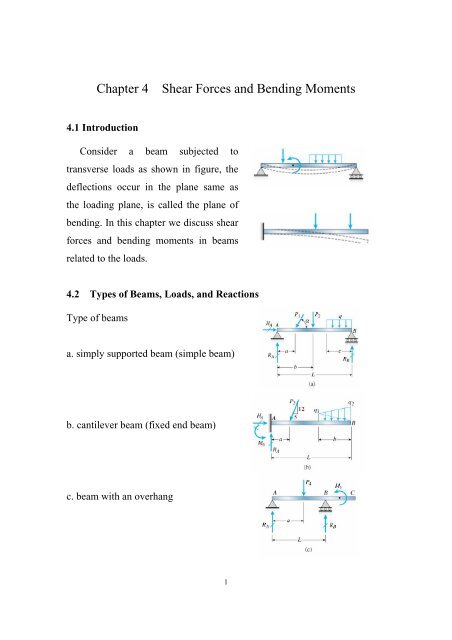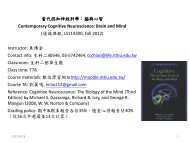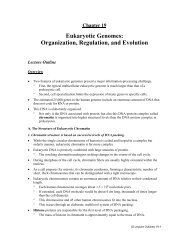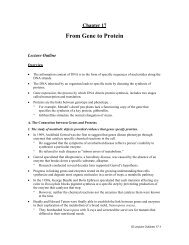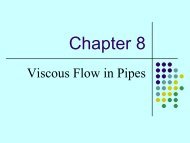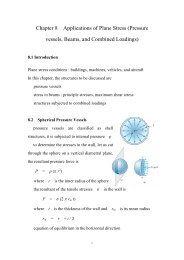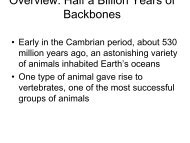Chapter 4 Shear Forces and Bending Moments
Chapter 4 Shear Forces and Bending Moments
Chapter 4 Shear Forces and Bending Moments
You also want an ePaper? Increase the reach of your titles
YUMPU automatically turns print PDFs into web optimized ePapers that Google loves.
<strong>Chapter</strong> 4<strong>Shear</strong> <strong>Forces</strong> <strong>and</strong> <strong>Bending</strong> <strong>Moments</strong>4.1 IntroductionConsider a beam subjected totransverse loads as shown in figure, thedeflections occur in the plane same asthe loading plane, is called the plane ofbending. In this chapter we discuss shearforces <strong>and</strong> bending moments in beamsrelated to the loads.4.2 Types of Beams, Loads, <strong>and</strong> ReactionsType of beamsa. simply supported beam (simple beam)b. cantilever beam (fixed end beam)c. beam with an overhang1
M = 0 M + 2 (q 0 x / L) (x) (x / 3) = 0M = - q 0 x 3 / (6 L)M max = - q 0 L 2 / 6Example 4-3an overhanging beam ABC issupported to an uniform load of intensityq <strong>and</strong> a concentrated load P, calculatethe shear force V <strong>and</strong> the bendingmoment M at Dfrom equations of equilibrium, it is foundR A = 40 kNR B = 48 kNat section D F y = 0 40 - 28 - 6 x 5 - V = 0V = - 18 kN M = 0- 40 x 5 + 28 x 2 + 6 x 5 x 2.5 + M = 0M = 69 kN-mfrom the free body diagram of the right-h<strong>and</strong> part, same results can beobtained4.4 Relationships Between Loads, <strong>Shear</strong> <strong>Forces</strong>, <strong>and</strong> <strong>Bending</strong> <strong>Moments</strong>consider an element of a beam of lengthdx subjected to distributed loads qequilibrium of forces in vertical direction5
concentrated loadsequilibrium of forceV - P - (V + V 1 ) = 0or V 1 = - Pi.e. an abrupt change in the shear force occursat any point where a concentrated load actsequilibrium of moment- M - P (dx/2) - (V + V 1 ) dx + M + M 1 = 0or M 1 = P (dx/2) + V dx + V 1 dx j 0since the length dx of the element is infinitesimally small, i.e. M 1is also infinitesimally small, thus, the bending moment does not change aswe pass through the point of application of a concentrated loadloads in the form of couplesequilibrium of force V 1 = 0i.e. no change in shear force at the point ofapplication of a coupleequilibrium of moment- M + M 0 - (V + V 1 ) dx + M + M 1 = 0or M 1 = - M 0the bending moment changes abruptly at a point of application of acouple7
4.5 <strong>Shear</strong>-Force <strong>and</strong> <strong>Bending</strong>-Moment Diagramsconcentrated loadsconsider a simply support beam ABwith a concentrated load PR A = P b / L R B = P a / Lfor 0 < x < aV = R A = P b / LM = R A x = P b x / Lnote that dM / dx = P b / L = Vfora < x < LV = R A - P = - P a / LM = R A x - P (x - a) = P a (L - x) / Lnote that dM / dx = - P a / L = VwithM max = P a b / Luniform loadconsider a simple beam AB with auniformly distributed load of constantintensity q8
R A = R B = q L / 2V = R A - q x = q L / 2 - q xM = R A x - q x (x/2) = q L x / 2 - q x 2 / 2note thatdM / dx = q L / 2 - q x / 2 = VM max = q L 2 / 8 at x = L / 2several concentrated loadsfor 0 < x < a 1 V = R A M = R A xM 1 = R A a 1for a 1 < x < a 2 V = R A - P 1M = R A x - P 1 (x - a 1 )M 2 - M 1 = (R A - P 1 )(a 2 - a 1 )similarly for othersM 2 = M max because V = 0 at that pointExample 4-4construct the shear-force <strong>and</strong> bending-moment diagrams for the simple beamABR A = q b (b + 2c) / 2LR B = q b (b + 2a) / 2Lfor 0 < x < aV = R AM = R A x9
for a < x < a + bV = R A - q (x - a)M = R A x - q (x - a) 2 / 2for a + b < x < LV = - R B M = R B (L - x)maximum moment occurs where V = 0i.e.x 1 = a + b (b + 2c) / 2LM max = q b (b + 2c) (4 a L + 2 b c + b 2 ) / 8L 2for a = c, x 1 = L / 2M max = q b (2L - b) / 8for b = L, a = c = 0(uniform loading over the entire span)M max = q L 2 / 8Example 4-5construct the V- <strong>and</strong> M-dia for thecantilever beam supported to P 1 <strong>and</strong> P 2R B = P 1 + P 2M B = P 1 L + P 2 bfor 0 < x < aV = - P 1M = - P 1 xfora < x < LV = - P 1 - P 2 M= - P 1 x - P 2 (x - a)10
Example 4-6construct the V- <strong>and</strong> M-dia for thecantilever beam supporting to a constant uniformload of intensity qR B = q L M B = q L 2 / 2then V = - q x M = - q x 2 / 2alternative methodV max = - q L M max = - q L 2 / 2xV - V A = V - 0 = V = -∫ q dx = - q x0M - M A = M - 0 = M =x-∫ V dx = - q x 2 / 20Example 4-7an overhanging beam is subjected to auniform load of q = 1 kN/m on AB<strong>and</strong> a couple M 0 = 12 kN-m on midpointof BC, construct the V- <strong>and</strong> M-dia forthe beamR B = 5.25 kNR C = 1.25 kNshear force diagramV = - q xV = constanton ABon BC11
ending moment diagramM B = - q b 2 / 2 = - 1 x 4 2 / 2 = - 8 kN-mthe slope of M on BC is constant (1.25 kN), the bending momentjust to the left of M 0 isM = - 8 + 1.25 x 8 = 2 kN-mthe bending moment just to the right of M 0isM = 2 - 12 = - 10 kN-m<strong>and</strong> the bending moment at point C isM C = - 10 + 1.25 x 8 = 0as expected12


